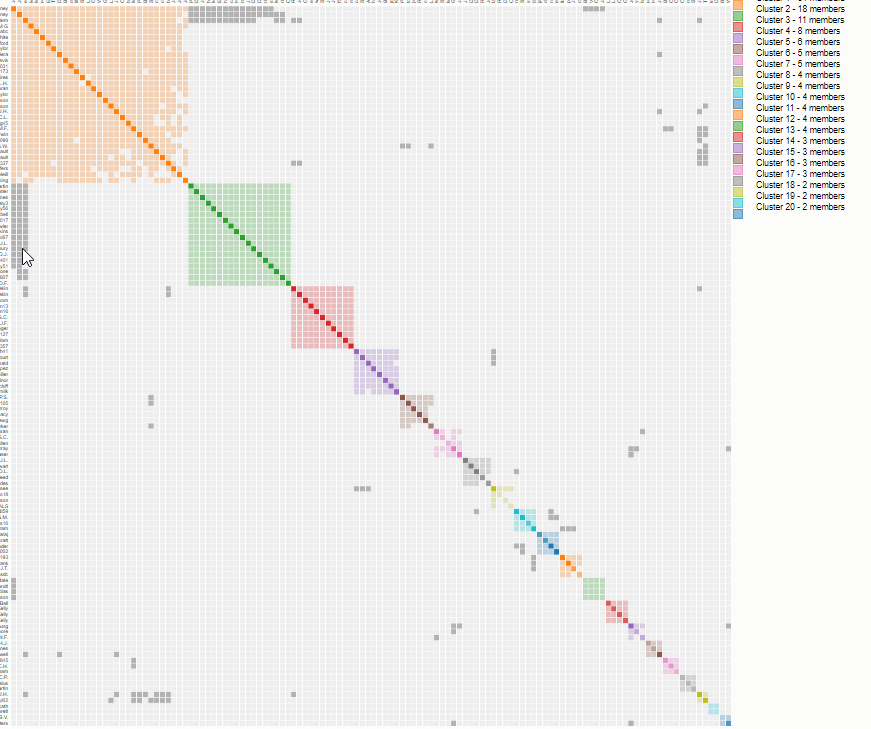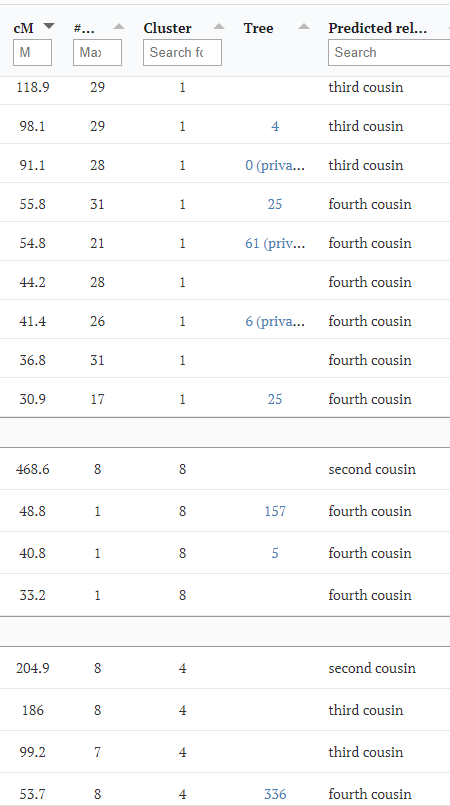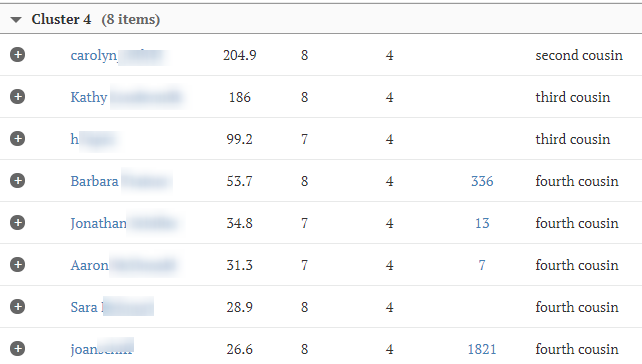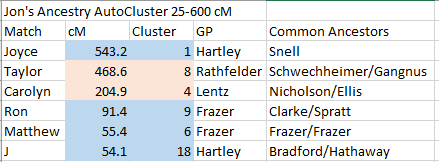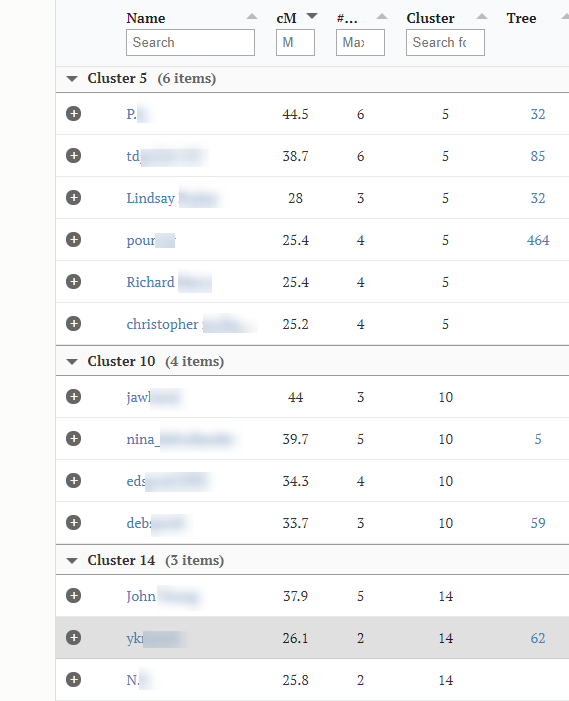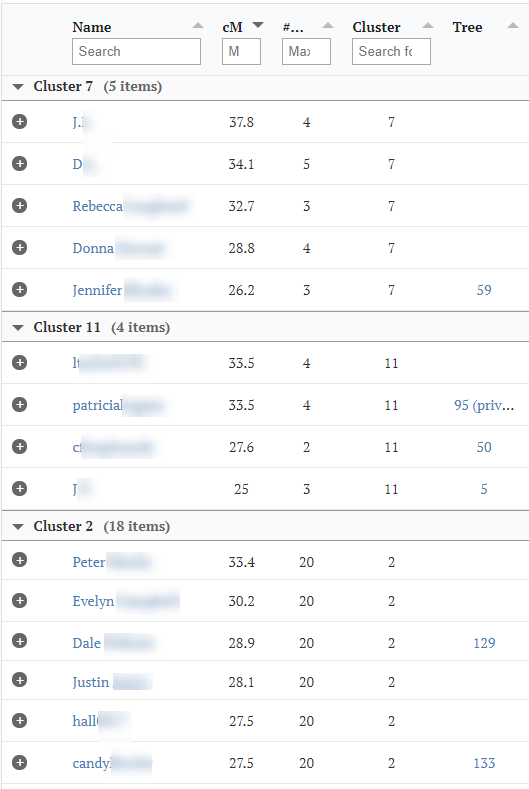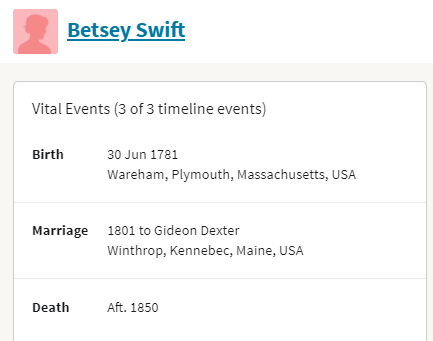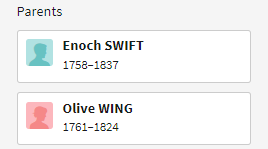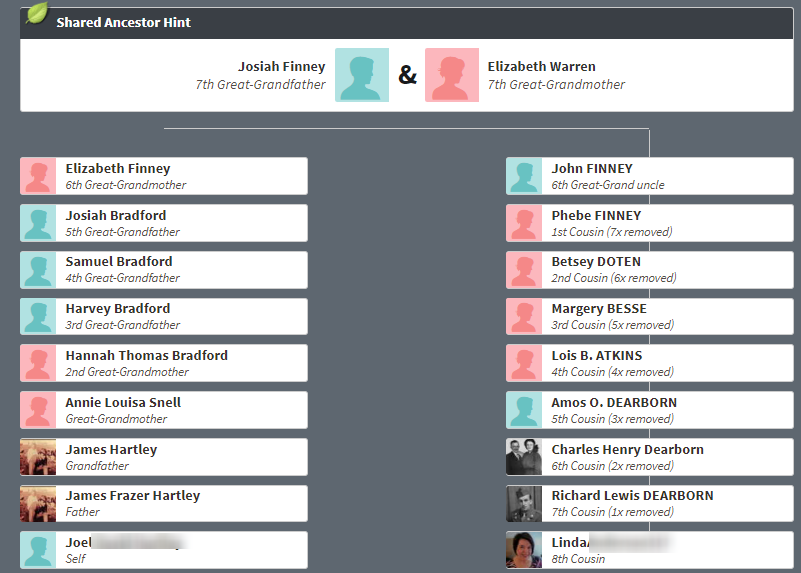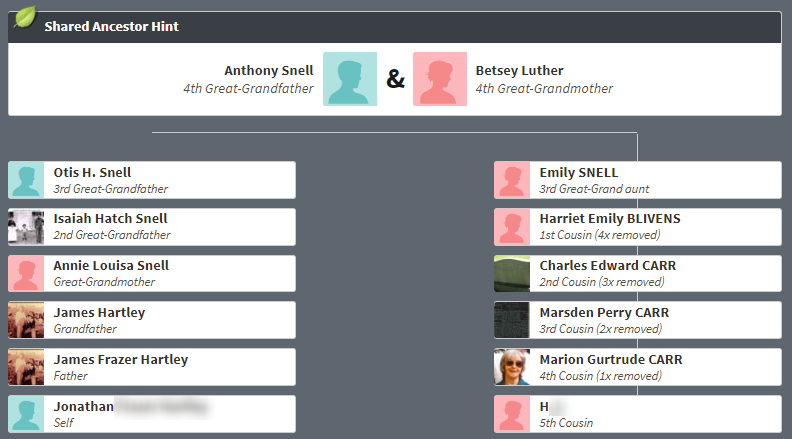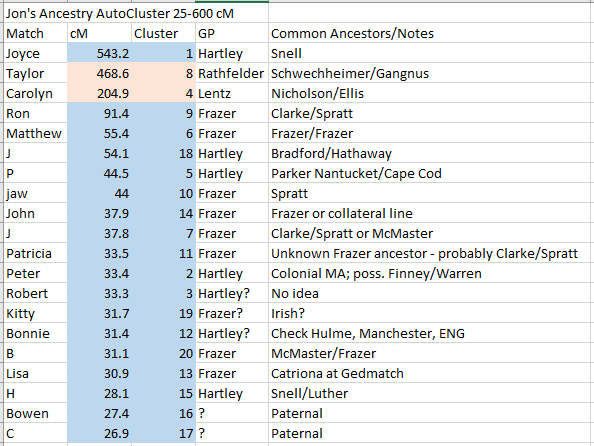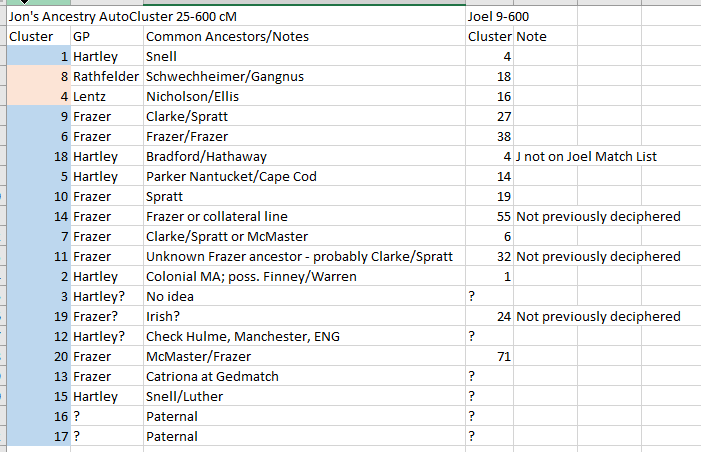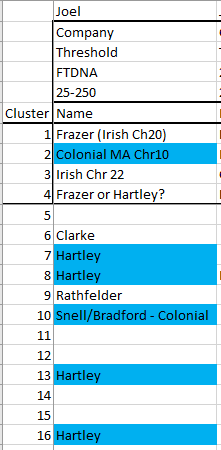I ran an AutoCluster and was surprised by the new look. I ran autocluster for my sister Lori:
The old look organized the clusters by how many were in the cluster. This newer, more logical approach organizes the clusters better to take into account the little gray dots.
Lori’s First 6 Clusters
It seems like these clusters could be related. There are four gray boxes connecting the small Cluster 2 to Cluster 1. There is one gray cluster connecting the red Cluster 3 to the green Cluster 2. And so on. I can tell that Lori’s orange Cluster 1 contains many 2nd cousins on my Hartley side and slightly more distant Snell relatives.
Lori’s Irish Clusters 8 Through 18
This has taken a lot of the guesswork away. I like that.
- The top left Clusters 8 and 9 (green and blue) contain some of my matches with Frazer ancestry.
- Green Cluster 12 has someone who I believe matches on a McMaster/Frazer Line.
- Cluster 15 between purple and pink is an important match that goes to my Clarke/Spratt Lines. They also match on McMaster. They are swimming in a sea of what I believe to be other Irish matches.
- The last lower right cluster contains the Spratt name where I have a brick wall.
Here is my Irish portion of my tree:
The clusters virtually mimic my tree which has Frazer at the top and Spratt at the bottom.
Lori’s Known and Unknown Clusters
Just by looking at Lori’s clusters I can tell the following:
- Clusters 1-6: Paternal Hartley 2nd cousins back to Massachusetts Colonial times
- Cluster 7: Maternal Nicholson/Ellis [Sheffield, England to Philadelphia]
- Clusters 8-18: Frazer, McMaster, Clarke and Spratt from Ireland
- Cluster 27: Maternal Lentz/Nicholson
- Clusters 28 and 29: Maternal Rathfelder ancestors back to Latvia
That leaves just Clusters 19 through 26 which are not obvious. That leaves only 8 unknown clusters.
Comparing Lori’s Clusters to My Mom’s and My Siblings’ Clusters
Here is how Lori’s clusters compare to her mom’s:
Cluster 3 was a surprise as that was in Lori’s paternal Hartley grouping above and it matches one of my mother’s clusters. I’ll won’t assign that as a maternal or paternal cluster for now.
Here is what I get when I compare Lori’s four other siblings who have tested at AncestryDNA:
- I gave Lori’s paternal Massachusetts grouping a blue color and her paternal Irish grouping a green color.
- Lori has two new clusters where she doesn’t match anyone else’s clusters. These are Clusters 19 and 25. I assume that they are paternal clusters as they don’t match with her mother’s clusters.
- My ancestors from Ireland were Protestant and married Protestants for the most part. This resulted in some inter-marriage of families. I assume that this is why Jon’s Cluster 6 is reflected in Lori’s Clusters 8, 9 and 10. Sharon’s Clusters 11 and 18 each show up in more than one of Lori’s clusters, etc.
Fleshing Out Lori’s Hartley and Frazer Mega-Clusters
Hartley – Colonial Massachusetts
The Hartley Clusters in blue seem to go quickly from 2nd cousins to Colonial Massachusetts. I still haven’t looked at Cluster 3 which is oddly shared with my mother. I suspect that it is indeed a paternal cluster as it is a lower numbered cluster for my sister and Jon than for my mother. Also there is a connection between Lori’s Cluster 3 and her Cluster 2.
Frazer – Ireland
Cluster 17 is interesting as the match with Keith goes back to two McMaster common ancestors:
With this information, I could go back to Sharon’s Cluster 15. I see that Keith is not Sharon’s largest match in her Cluster 15, but he is in that Cluster, so I can fine tune Sharon’s Cluster 15 to McMaster.
Lori’s New Clusters 19 and 25
There are only two people in Cluster 19. Their trees are not extensive and the match numbers are not impressive. I will just call this cluster paternal for now.
Cluster 25 and Peter
Peter is interesting as he shows one of his grandparents from Australia. If this match is on my Hartley side, that could go back to my English Hartley’s. I am interested in Peter’s Howarth ancestry as it could be linked to my Howorth ancestry from Lancashire, England. I just need to build out Peter’s tree
Peter’s Howarth Line goes back from Australia then to Ireland then to Rochdale, England where my Howorths were from. However, he also has an Irish Whiteside in there. I may be related to the Whiteside family. At this point, I’m leaning toward Howarth/Howorth in Rochdale, but I’ll just say it’s a paternal match for now.
Done with Lori’s Clusters – For Now
This is about as much as I have patience for right now. I had originally thought that Sue at Lori’s Cluster 26 was Massachusetts Colonial, but Sue uploaded her results to gedmatch and that showed that she matched us on our Frazer side.
Summary and Conclusions
- Lori was the first autocluster that I have looked at with the new mega-clustering feature. This put our birds of a feather ancestors together.
- This new rendering of the clusters helped me to see how my paternal Hartley and Frazer ancestors related to each other.
- Two small maternal clusters showed relationships which confirmed a suspected Latvian ancestor cluster.
- Cross-referencing Lori’s clusters to my mom’s and her siblings’ clusters helped to fine-tune these clusters.
- Lori had two unique clusters. However, they were difficult to nail down past being paternal clusters.













































